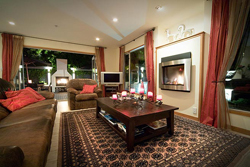During our visit
to New Zealand in 2007, we spent a day in Central Otago
visiting some of the vineyards in the area. Which was a
very pleasant way to spend a day.
Grapes grown in Central Otago
While New Zealand is
best known for it's Sauvignon Blanc, Pinot Noir is the dominate
grape to be planted in the Central Otago region comprising
around 85% of vineyard plantings. Small amounts of Chardonnay,
Pinot Gris and Reisling have also been planted. While minor
amounts of Sauvingon Blanc and Gewürztraminer have also
been planted.
The sub regions
Four distinct areas make up the Central Otago wine growing
region. Most of the regions vineyards are located in the
Cromwell basin which includes Bannockburn in the South, Lowburn,
Wanaka Road and Bendigo.
The second largest growing area is around Gibbston where
the vines are typically north-facing fans and terraces above
Kaawarau Gorge. Clyde and Alexandra vines tend to be grown
amonsgt schist rocks and a small number of vines are grown
around Wanaka which tend to be against a somewhat dramatic
background of Lake Wanaka and the mountains.
Soil
The soil of Central Otago are varied and range from light
sands to heavy silts and schist. Most soils are from loess
or alluvial deposits. Underneath gravels allow for good drainage.
In some areas in the west, there is also glacial otwash or
moraine.
Climate
The climate of Central Otago is semi-continental which means
that there is a greater variation in daily and seasonal tempratures.
Summers are typically hot and dry while autumns are cool
and dry with cold nights. Rain falls evenly through the year
with greater rain fall in the west of the area - which is
the area around Wanaka. Comparativly low rainfall results
in low inciden of botrylis and fungal diesasse which limits
the need for spraying of the grapes. Conversely, however,
frosts can occur through the winter months of March to November.
This impacts the vine growing season and needs to be controlled.
As a result, many vineyards are north-facing and flatter
vineyards have wind machines, water sprinklers and misting
systems. Controlling frost by use of helicopters is not unknown
but comes at a significantly higher operating cost than the
more capital-intensive machines. Additionally, introduced
predators such as rabbits pose and additional problem.
What to look for
The Central
Otago Winegrowers Association have placed various brown
coloured road signs throughout the region which help you
easily find where the various vineyards in Central Otago
are. During our 2007 trip to Central Otago, it was pretty
clear to us when we were approaching a vineyard and where
it was. Which is handy if you just want to pop into a vineyard
during your trip - but be sure to have a designated driver
(I do not under any circumstance support drink-driving
so designate a driver who will stay sober while you sample)
If all of you wish to participate in wine tasting, I can
recommend Appellation
Central who did a great tour for us in 2007.
Harvest
Harvest time in Central Otago is typically April to May.
Buying Central Otago wine
I've never found Central Otago wine outside New Zealand
and, in my experience, it's been difficult to get Central
Otago wine outside of the region itself - even within new
Zealand. Wine production volumes tend to be small and the
number of vineyards is, on a relative basis, is high. Many
vineyards supply local restaurants and bars and this often
comprises most of their sales. Your best bet, therefore,
is simply to goto Central Otago and try the stuff in-situ.
Which is, generally, the best approach to wine anyway. So
there!
 A couple enjoying the sunset over lake Wakatipu at Queenstown
A couple enjoying the sunset over lake Wakatipu at Queenstown
 The Earnslaw cruising on Lake Wakatipu at Queenstown in Central Otago
The Earnslaw cruising on Lake Wakatipu at Queenstown in Central Otago
 Recommended hotels and motels New Zealand's South Island
Recommended hotels and motels New Zealand's South Island
 Video of the flight over and landing in the Milford Sounds in Fiordland on the South Island of New Zealand
Video of the flight over and landing in the Milford Sounds in Fiordland on the South Island of New Zealand
 Mouth of Milford Sound seen from the cockpit on a scenic flight
Mouth of Milford Sound seen from the cockpit on a scenic flight
 View of the Southern Alps on the flight to Milford Sounds
View of the Southern Alps on the flight to Milford Sounds
 View down Lambton Quay, the main shopping centre in the Wellington CBD
View down Lambton Quay, the main shopping centre in the Wellington CBD
 Reflections in a glass building in the CBD of Wellington
Reflections in a glass building in the CBD of Wellington